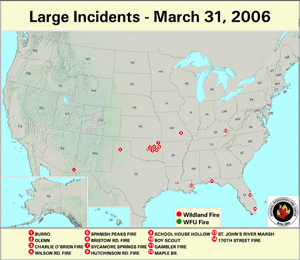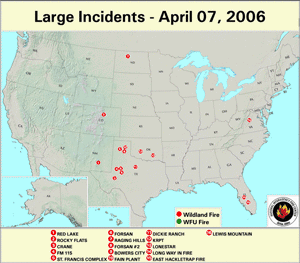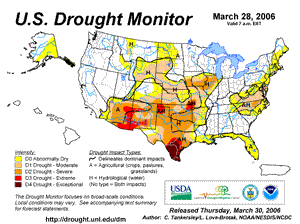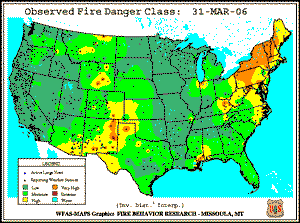Wildland fire activity remained much above normal during March, as numerous fires affected parts of the central and southern U.S. The outbreak of fires that had initially developed at the end of 2005 continued over the past month despite several short periods of relief. Fire activity recently spread to Florida in early April.
There have been over 22,000 fires across the lower 48 states since the beginning of 2006, with large fire activity primarily focused in the central and southern Plains (mainly in Texas and Oklahoma), the Southwest and the Florida peninsula. Over 1.8 million acres have burned across the contiguous U.S. so far this year, according to the most recent estimates from the National Interagency Fire Center, with approximately 1.5 million acres burned in the Southern Area (which encompasses 13 states, Puerto Rico, the Virgin Islands and the District of Columbia).
During March, anomalously dry weather continued across the southern Plains region, where long–term drought conditions have persisted over the past year. The winter and early spring is typically a period when wildland fire activity is relatively low across the contiguous U.S., but both the number of fires and the acreage burned have been anomalously large this year.
| Totals as of early April | Nationwide Number of Fires | Nationwide Number of Acres Burned |
|---|---|---|
| 4/5/2006 | 22,564 | 1,872,701 |
| 4/5/2005 | 9,631 | 143,898 |
| 4/5/2004 | 15,577 | 171,677 |
| 4/5/2003 | 8,547 | 129,015 |
| 4/5/2002 | 16,060 | 266,383 |
| 4/4/2001 | 15,307 | 284,907 |
Dead fuel moisture levels were unusually dry during March. In early April, the 10–hour fuel moisture levels remained extremely dry, with the observed levels below 5% across parts of the Plains and Southwest states.
Medium to larger fuels (i.e., the March 31st 100–hr and March 31st 1000–hr fuel moistures) also remained unusually dry during March, especially across New Mexico, western Texas, southeast Colorado, and western Oklahoma and Kansas.
The Keetch–Byram Drought Index (KBDI), a widely used index for fire risk, had the largest potential for wildland fire activity in the contiguous U.S. across parts of the Southwest, southern Texas, and southern Florida at the end of March. In addition, the observed experimental fire potential index in early April was also anomalously high for a large area of the Southwest.
For further information on drought conditions across the U.S. go to the March drought summary page.
 NOAA's National Centers for Environmental Information
NOAA's National Centers for Environmental Information



